Types and best varieties of perennial petunia
Scientists studying varieties and varieties of petunia classify it as a perennial plant. Science knows about 25 species that have fundamental differences. However, there is a classification according to which the crop is divided into several groups depending on the shape of the bush and the size of the buds. In this article we will talk about the features of ampelous, large-flowered, multi-flowered varieties and floribunda petunia.
Are there perennial petunias?
Petunia is a perennial herbaceous or subshrub plant of the Solanaceae family. Natural habitat is tropical countries (Brazil, Argentina, Uruguay, Bolivia). Sometimes petunia is found in North America.
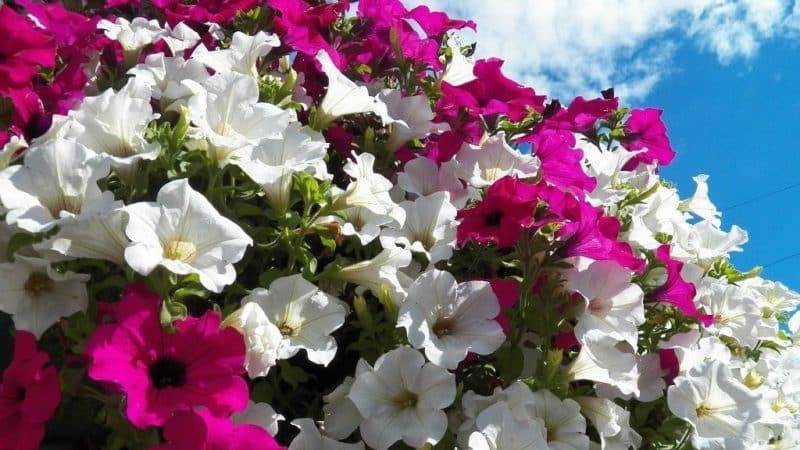
The name of the flower comes from the word petun, which means “tobacco” in Brazilian. The name appeared for a reason; in fact, petunia is a relative of real tobacco. The plant became widespread in the 18th century. and quickly won the love of flower growers.
Perennial petunia is usually grown as an annual. The exception is the hybrid form of culture - Petunia Gioconda F1. The plant does not produce seeds and reproduces vegetatively. A distinctive feature of the hybrid is lush flowering lasting up to 12 months.
Description of perennial petunia
Perennial petunias are propagated by seeds and cuttings, depending on the species. Terry varieties yield little seeds, therefore they are mainly propagated cuttings.
Description of perennial petunia:
- Perennial petunia is a herbaceous or subshrub plant.
- Stems are erect or creeping, branched with a slight pubescence. Height - 15-70 cm depending on the type.
- The leaves are oval, entire, green or dark green in color, 5-12 cm in diameter.
- Single flowers are located on short peduncles. The shape is funnel-shaped, regular and irregular, fringed and terry.
- The variety of shades is amazing. There are flowers of scarlet, red, violet, pink, lilac, blue, blue, white, yellow. There are varieties with contrasting borders, stripes, halo or speckled patterns.
- Flowering period – July – October. In place of the withered flower, a fruit appears in the form of a box with small seeds.
To extend the life of this amazing flower, in the fall, flower growers dig up a bush along with a lump of earth and transplant it into pot. The container with the flower is sent to the basement for storage, and with the arrival of spring, it is taken out into the sunlight and watered abundantly. The roots of the petunia come to life, and the plant quickly grows.
Reference. Petunia is an annual or perennial plant that is grown in open ground, flowerpots or flower pots on balconies or verandas.
Types and best varieties of perennial petunia
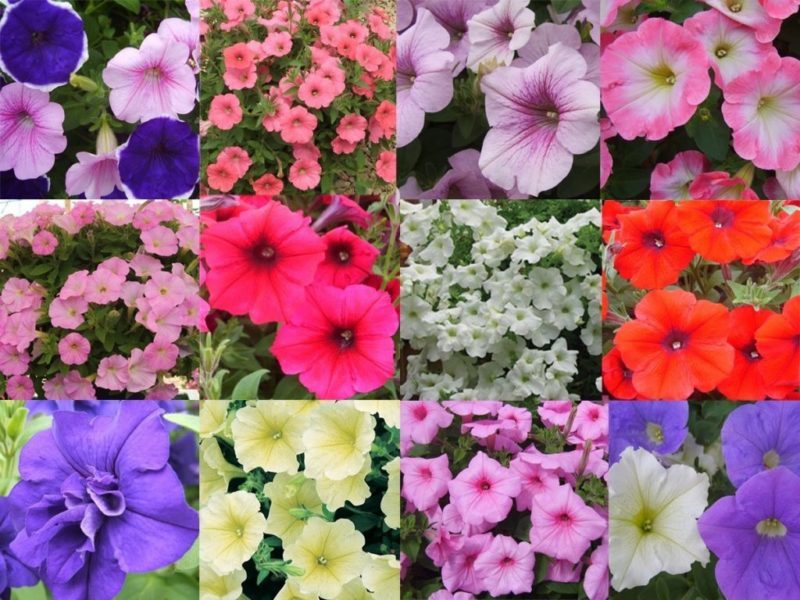
Despite the fact that scientists began studying petunia more than 200 years ago, a general scientific classification of the culture has not yet been presented. However, there are several main types of plants: multi-flowered, small-flowered, ampelous and floribunda petunia.
Ampelnaya
Ampelnaya perennial petunia It is distinguished by hanging vines 0.5-1.5 m long, thanks to which it looks amazing in hanging flower pots on verandas, balconies and terraces.This group is characterized by low maintenance and resistance to unfavorable climates. Such varieties are also called balcony or garden varieties.
Ampelous petunias are characterized by long flowering with a small number of funnel-shaped or bell-shaped buds. The petals are smooth, simple or covered with small folds, the edges are smooth, fringed or carved. The diameter of the rims is 15-80 mm. The coloring is varied: plain, 2- or 3-color, with many veins, a dark or light border and the same core.
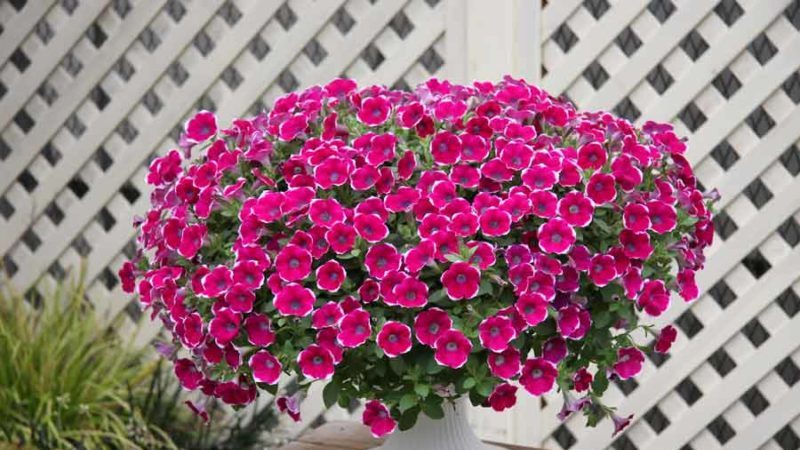
The most popular:
- Conchita Series with small flowers up to 5 cm in diameter. Various shades: scarlet, white, blue, purple, pink, yellow, blue.
- Wave Series when planted in open ground, it creates wide flower carpets that are weather-resistant. The plant blooms profusely and for a long time. The flowers are funnel-shaped, 50-70 cm in diameter. Bud color: dark blue, purple, lavender, soft pink, deep pink, light lilac.
- Avalanche F1 - an amazing series of ampelous petunias with shoots 60-80 cm long. When planted in a pot or cache-pot, it forms flowing “streams” of large buds with wide corollas. The diameter of the flower reaches 70-90 mm. When planted in open ground, the branching stems create a dense flower carpet with a diameter of 1.6 m. The color is purple, orange, red, yellow, white, blue, salmon, pink. The palette of shades expands due to the veins and white stripes emerging from the core of the flower.
- Velvet Series represented by plants with hanging stems 0.8-1 m long. The varieties are distinguished by high growth vigor and resistance to diseases.Numerous buds with a diameter of 50-70 mm are wonderful honey plants, so varieties of this series are planted in vegetable gardens and orchards to attract bees to crops that need pollination. These petunias are characterized by late flowering. Flower color: dark pink, salmon, purple. The petals have light yellow or dark, almost black veins.
- Decorative series Opera Supreme F1 with flexible shoots 1 m long, it is resistant to direct sunlight. Thanks to strong branching, the shoots form openwork lashes, spherical or teardrop-shaped bushes, covered with small funnel-shaped buds with a diameter of 50-60 mm. Petal color: blue, blue, pale lilac, white, purple, light pink, crimson.
Large-flowered
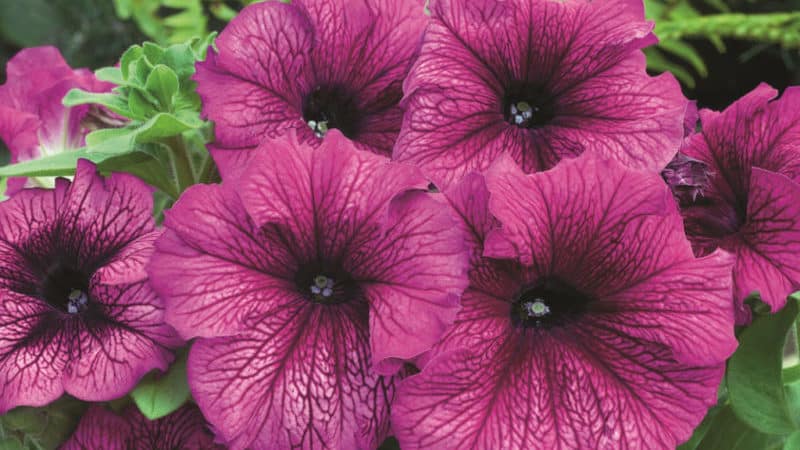
Grandiflora petunia is a perennial flower also known as grandiflora. This is the most popular and widespread variety of the plant, which is distinguished by large flowers with a diameter of 8-12 cm.
This group of petunias includes several subgroups:
- high - up to 60 cm in height;
- low - up to 30 cm;
- fringed low and high - 25-75 cm;
- excellent low and high - 30-75 cm;
- terry - 50-60 cm.
Double Cascade F1
A series of low plants (25-35 cm) with highly branching stems that form compact bushes. The flowers are large, funnel-shaped, double, 12-13 cm in diameter. Bud colors: burgundy, dark blue, lavender pink, soft pink, lavender. The surface of the petals is smooth or veined.
Galaxy F1
It is distinguished by branched compact bushes 25 cm high. The flowering period is from May to October. The flowers are funnel-shaped, snow-white, with a star-shaped center and lacy petals with wavy edges. Flower diameter is 8-10 cm.
Black velvet
The variety was bred by British breeders. The height of the bushes is 35 cm, diameter is 25-30 cm. The stems are branched, the flowers are large, bell-shaped, colored dark purple, almost black. The diameter of the flower reaches 80 mm. The surface of the petals is velvety. The flowering period is from May to the end of September.
Sferika F1
The universal series is used for decorating lawns, verandas and balconies. Stems 25 cm high create a dense bush with a diameter of up to 30 cm. Flowers are funnel-shaped, dark purple, salmon, soft pink, blue. The diameter of the corolla reaches 12 cm. The plants are resistant to prolonged rains.
Sophistry F1
The series is represented by a group of varieties bred by American breeders. Herbaceous stems reach 40 cm in height, forming spherical bushes with a diameter of 30 cm due to good branching. The divided petals with smooth or wavy edges form simple flowers with a diameter of 8-10 cm.
The color of the flowers is blue-blue with a shining white core, soft pink with creamy-white streaks, black with a purple tint, lemon green or pink with greenish-yellow splashes. Shades may vary depending on the lighting: the more sunlight, the brighter the color of the buds.
Multiflora
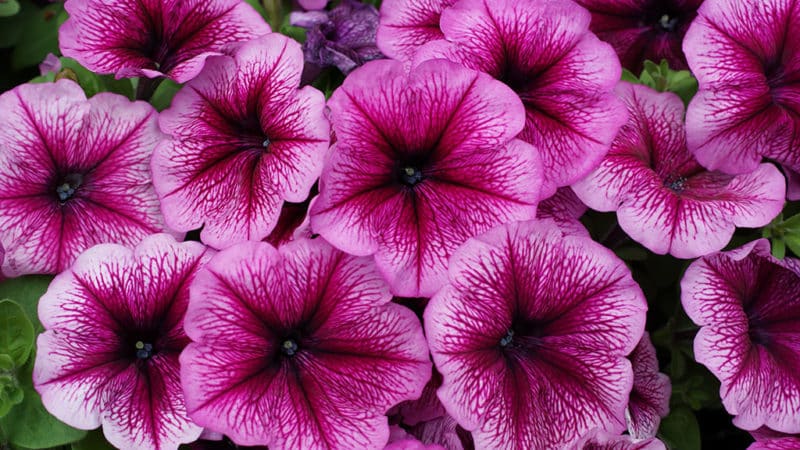
Multi-flowered petunia has a second name - multiflora. The plant has small flowers and begins flowering in mid-April. During intensive flowering, small flowers with a diameter of 5 cm appear on the bushes. Representatives of this group are famous for their ease of care and resistance to bad weather.
Popular:
- Fantasy Series includes 9 hybrid varieties up to 20 cm high. Flower color: white, burgundy-crimson, plain and with contrasting veins.
- To the Mirage series includes 13 hybrids of terry petunias. The diameter of the flowers is 6-9 cm. Various colors: blue, white, scarlet, orange, pink, lilac, purple, blue.
- Celebrity Series F1 consists of 13 low-growing hybrids with small flowers with a diameter of 5 cm. The petals are decorated with contrasting, bright veins that create a fine mesh pattern at the base of the funnel. Flower color: lilac-pink with burgundy veins, salmon-red with dark veins, white with blue stripes, blue-violet, dark red.
- Pikoti F1 series bred by American breeders. It includes 5 hybrids with flowers of original shades. The bushes are compact, low-growing - up to 25 cm. Petals have a white border and corrugated edges. Bud color: red, crimson, pink, purple, violet-blue.
- Variety Glafira It is distinguished by highly branching straight shoots up to 30 cm high. Flowering is abundant, from May until the first frost. The diameter of the corolla is 45-65 mm. Petals with smooth round edges. Various colors: blue, red, white, pink, purple.
Floribunda
Floribunda, or abundantly flowering petunia - an intermediate group of plants between multi-flowered and large-flowered petunias. The flowers have absorbed the distinctive features of 2 types: large flowers and ease of care. Floribunda looks beautiful outdoors on a large scale because the shoots do not branch well. Petunia is grown as an annual or perennial.
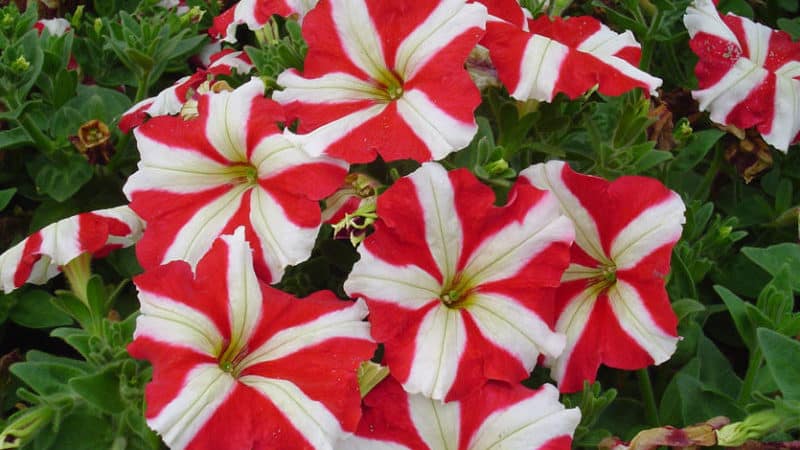
Sonya F1
One of the most popular series includes 11 hybrid varieties. The bushes are compact, low-growing, 25 cm high. The flowers are simple, with a diameter of 60-80 mm. Color: pink, crimson, red, white, raspberry-burgundy, blue-violet.Many varieties are bicolor: pink-lilac with lilac-burgundy veins, raspberry-pink or raspberry-burgundy with a white star in the middle, light purple with dark veins, or red with a white border.
Milky Way F1
A low-growing plant up to 25 cm high. The shoots are branched and erect. The flowering period is from May to October. The petals are lacy, snow-white, wavy at the edges, with a pink star inside. The diameter of the corollas reaches 10 cm. The culture is resistant to bad weather; the flowers do not fall off after heavy rains.
Angora F1
A hybrid with branched, erect shoots forming a bush 45 cm high. The flowering period lasts from June until the first frost. The bushes are strewn with large double flowers with a diameter of 70 mm. The petals are pink with wavy edges.
Conclusion
Flower growers grow petunia as an annual or perennial. From a scientific point of view, it is a perennial plant that is adapted to hot climates and can bloom for a long time. In mid-latitudes, petunia is often grown as an annual crop due to the climate. The flowering period begins in April - May and ends with the arrival of the first frost.
The most popular types of perennial petunia are ampelous, multi-flowered, large-flowered and profusely flowering. The variety of shades is amazing: funnel-shaped or bell-shaped flowers form smooth or velvety petals with straight, corrugated or wavy edges. Perennial petunia is easy to care for and blooms profusely.